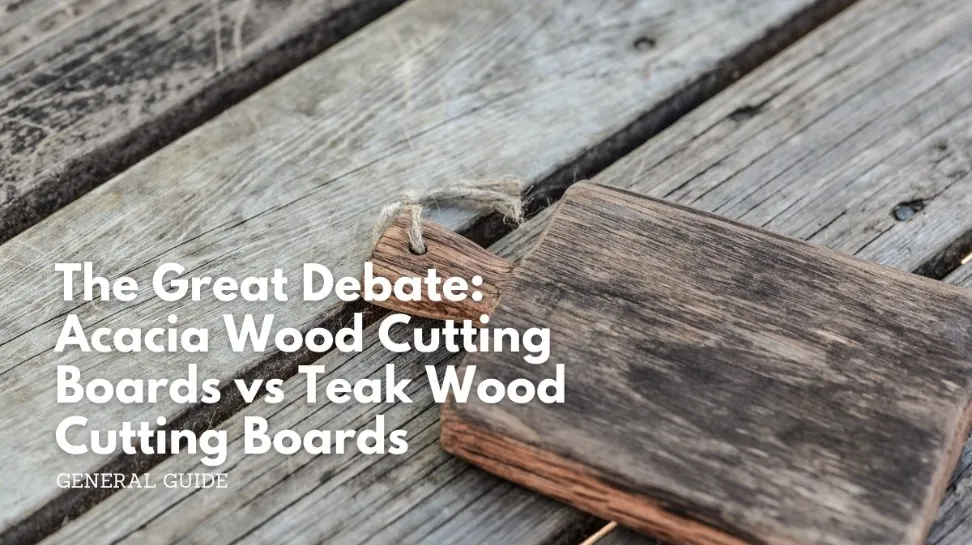The Great Debate: Acacia Wood Vs. Teak Wood For Cutting Boards!
Over the years, the two woods that seem to be the most popular choices for cutting boards are acacia and teak – and for good reason. Both woods are highly durable and resistant to cuts, marks, and moisture. However, they each have their unique characteristics that make one better suited for certain kitchen tasks over the other.
If you’re in the market for a new cutting board, I’m here to share my insights on acacia and teak so you can decide which type is the best fit for your needs. From handling raw meats to serving cheeses and fruits, cutting boards play a crucial role in kitchen prep. Getting the right material is important not only for your culinary tasks but also for food safety.
In this article, I’ll break down the key differences between acacia and teak woods – exploring aspects like hardness, bacteria resistance, maintenance needs, and more. By the end, you’ll have a better understanding of the pros and cons of each type so you can pick the cutting board champion for your cooking style.
Table of Contents
Features comparison
Here, I’ll be comparing Acacia wood cutting boards and Teak wood cutting boards side-by-side based on the 7 most common cutting board features below:
1. Durability
Both Acacia and Teak boast remarkable resistance to wear and tear thanks to their dense grain structure.
Keep in mind that any cutting boards not properly constructed coupled with soaking it in water will lead to warping and cracking after a long period of time.
Acacia, with its exceptional hardness, is well-suited to withstand daily dents and scratches from chopping, slicing, and dicing. Its tight cellular composition makes it tough enough to last for decades with proper hand washing and oiling.
However, Teak may have a slight edge in durability due to its high oil content within the wood. These natural oils act almost like a protective sealant for the grain, boosting Teak’s ability to avoid warping or scratches even under heavy cutting pressure over extended periods of use.
2. Ease of Maintenance
While both Acacia and Teak cutting boards produce long-lasting service in the kitchen, they differ slightly in their maintenance needs. Acacia wood, with its intricate grain patterns that add visual appeal to any countertop, requires a bit more TLC to keep it looking its best over time. As a porous wood, Acacia is thirstier than Teak and benefits from a quick conditioning after each soap-and-water cleaning. Taking just a few extra minutes to rub on a light layer of mineral oil helps saturate the wood fibers, shielding Acacia from drying out or developing splits from repeated exposure to water and air.
Related: Read this article to learn how to care for Acacia wood cutting boards.
Teak wood, on the other hand, is quite content to rely on its natural defenses. With an oily composition that causes water to bead up like raindrops on a freshly waxed car, Teak resists the daily wear and tear of food prep to a certain level. While an occasional reapplication of oil every few months or so can’t hurt, Teak is largely self-maintaining.
The wood’s inborn oils coat and protect the surface from within on an ongoing basis, fending off nicks, cuts, and even mold with built-in armor. For a cook with little time to baby their boards, Teak’s low-maintenance composition makes it the better choice.
3. Knife-friendliness
Both kinds of wood excel at maintaining the sharpness of your knives due to their mid-range hardness levels.
Acacia boards absorb knife impacts well thanks to the natural resilience of the wood. This helps protect your blades from damage over time. However, its resilience means acacia holds up admirably against the test of time in any busy kitchen.
Teak boards also withstand the rigors of regular use, with a hardness rating that allows cutting without dulling knives prematurely. Its high silica content is key here – where some woods can be too hard on blades, teak has just the right composition to glide smoothly beneath the knife without degradation.
You truly can’t go wrong with either of these top-grade hardwood choices when you need a board that protects knives and stands up to extensive use.
4. Aesthetics
When it comes to aesthetics, Acacia and Teak boards truly stand out. Acacia is known for its intricate and unique grain patterns that reveal themselves like works of art with each use. No two Acacia boards are exactly alike, allowing cooks to find one-of-a-kind natural accents for their culinary workspaces. Their varying tones and textures add warmth and visual interest to a countertop.
At the same time, Teak boards impart sophistication with their sharp, uniform grains and warm golden hue. Where Acacia showcases the natural variability of wood, Teak displays an elegant uniformity that complements modern designs. Both lend an air of rustic elegance to a kitchen.
However, while Acacia’s grain patterns help disguise marks over time, Teak maintains a sharp definition suitable for presentation boards. In the end, aesthetic preference often comes down to whether one appreciates the organic complexity of Acacia or the refined simplicity of Teak. Both are guaranteed to enhance any kitchen space with their natural beauty.
Related: Read this article to get the proper tips on how to maintain your cutting boards, so they maintain their original aesthetics.
5. Sustainability
Acacia wood is generally more sustainable than teak wood.
Acacia trees grow rapidly across arid regions worldwide, often reaching maturity within 10-15 years. This rapid growth rate reduces pressure on harvesting slower-growing hardwoods from vulnerable tropical forests. Research also shows that Acacia plantations help sequester carbon from the atmosphere and preserve natural ecosystems when established in managed forests.
Teak wood presents more of a mixed picture in terms of sustainability. While teak forests can capture and store carbon long-term when maintained properly, the multi-decade maturation period for teak trees means their harvesting rate cannot match the renewal of Acacia in well-regulated forests. Some tropical teak sources also have higher eco-costs because of the energy required to transport this dense wood internationally.
6. Resistance to Bacteria
When it comes to preventing the growth of harmful bacteria, both Acacia and Teak wood cutting boards offer excellent options for food preparation. Acacia wood has a dense texture that makes it difficult for bacteria to penetrate the surface. Research shows that over 99% of bacteria are eliminated within three minutes of contact with an Acacia cutting board. This is due to the natural resistance of the wood to microbes.
Similarly, Teak wood contains oils that create an inhospitable environment for bacteria. The oils cause Teak to repel water, so it doesn’t absorb moisture that can harbor foodborne illness. Bacteria struggle to gain a foothold on Teak’s slick surface.
Overall, choosing either Acacia or Teak cutting boards will give you a surface that is very unlikely to transfer harmful microbes to your food during preparation. Both are excellent sustainable and hygienic options.
7. Cost
When it comes to price, Acacia wood and Teak wood cutting boards represent different points on the cost spectrum. As an experienced chef and cutting board enthusiast, I’ve spent years researching various wood varieties and have come to know their typical price ranges well. Acacia cutting boards provide a more affordable option, with quality boards available from around $30 to $80 depending on size and features. This makes Acacia a sensible choice for home cooks just starting to expand their kitchen tools or those working with a budget.
However, it’s important to note that Teak boards, while carrying a higher price tag, are engineered to deliver superior longevity.
Teak cutting boards start around $25 for smaller sizes, but serious cooks will likely want to invest in a large, high-quality board, which can range from $75 to over $100.
Teak vs Acacia Cutting Board Pros and Cons
Swipe for more ➔
| Material | Knife-friendliness | Durability | Maintenance | Aesthetics | Antibacterial Properties | Cost |
|---|---|---|---|---|---|---|
| Acacia | Ideal hardness with high silica content glides smoothly under blades | Exceptional hardness with dense grain structure; resists daily dents and scratches well with proper care | Requires more attention; needs conditioning after each wash and regular mineral oil application to prevent drying and splitting | Intricate, unique grain patterns; no two boards alike; varying tones add warmth and visual interest; grain patterns help disguise marks over time | Excellent; dense texture prevents bacterial penetration; eliminates over 99% of bacteria within 3 minutes of contact | More affordable; quality boards range from $35-$80 depending on size and features; sensible choice for budget-conscious cooks |
| Teak | Mid-range hardness absorbs knife impacts well, protecting blade edges | Superior durability due to high natural oil content acting as protective sealant; excellent resistance to warping and scratches under heavy use | Very low maintenance; natural oils are self-protecting; only needs occasional oil reapplication every few months | Uniform grain with warm golden hue; sophisticated and elegant appearance; sharp definition suitable for presentation boards; complements modern designs | Excellent; natural oils create inhospitable environment for bacteria; water-repellent surface prevents moisture absorption that harbors bacteria | Higher price point; small boards start around $25, but quality large boards range from $75 to over $100; superior long-term value |
Swipe for more ➔
Best Teak Wood Cutting Boards Under $100
Socisen 3 Pack Teak Wood Cutting Board Set for Kitchen Charcuterie Board
Best Acacia Wood Cutting Boards Under $100
WALDWERK Cutting Board Set out of Solid Acacia Wood – 0.8 in Thick Cutting Boards for Kitchen
Yes4All Durable Acacia Cutting Boards for Kitchen, Medium End Grain Cutting Board
Final Thoughts – which should you choose?
After reviewing both boards thoroughly, I’ve found that the best option truly comes down to individual priorities and needs.
Both Acacia and Teak offer unique advantages that make them excellent choices. However, if I had to select a personal overall favorite, I would have to give the edge to Teak boards. Their durability and resistance to nicks and cuts provide decades of dependable service without requiring replacement.
The upfront investment is higher for Teak, but considering the board will likely outlive Acacia boards, it proves to be excellent long-term value. That said, for those on a budget or who appreciate Acacia’s attractive grain patterns, an Acacia board is still a very sound choice that will serve you for decades with proper care.
Ultimately, you can’t go wrong with either, just be sure to select the type of board that aligns best with your unique priorities in the kitchen. I hope this comparison has helped you choose the ideal option for your needs.
This article contains affiliate links #ad








